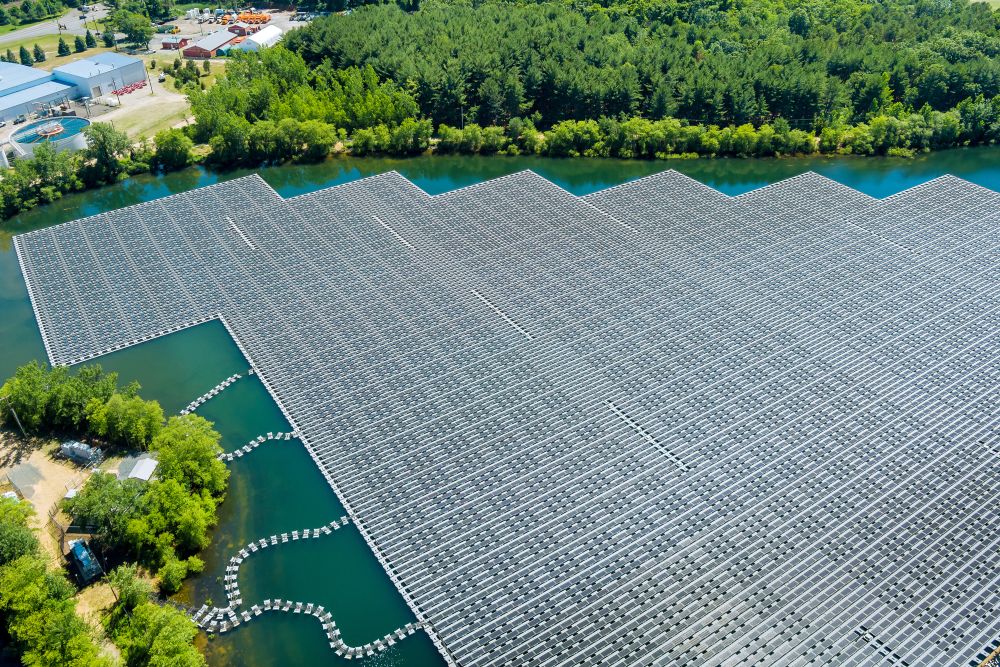
Floating solar technology is gaining attention not just for its environmental benefits, but increasingly for its economic logic. As businesses and utilities evaluate renewable energy investments, floating solar presents a compelling value proposition that combines energy efficiency, space optimization, and financial returns. While it’s still a relatively young sector, cost trends and early deployment data show that the economics of floating solar are becoming increasingly competitive.
Salinex, a pioneer in modular floating solar technology, has been closely monitoring these developments. “The technology is maturing rapidly, but the economics are where the conversation is heading,” says the company’s founder. “Clients want to know not only if it works — but how well it pays off.”
Floating solar cost factors and system economics
To understand floating solar cost structures, it’s useful to compare them with traditional ground-mounted systems. Floating installations typically have higher upfront costs — primarily due to floating structures, mooring systems, and water-specific engineering. On average, these costs are 10–25% higher per megawatt compared to land-based systems.
However, these added costs are often offset by significant operational and strategic benefits. For one, floating systems reduce land acquisition expenses — particularly valuable in densely populated or high-cost real estate markets. Second, their cooling effect on panels improves energy yield, offering 5–15% higher output efficiency. Over the life of the system, this improved performance has a measurable impact on return on investment (ROI).
Additionally, co-location with existing infrastructure — such as hydropower plants or industrial reservoirs — lowers connection and permitting costs. This integration of floating solar cost efficiencies across the lifecycle makes the technology financially viable in more use cases than ever before.
Evaluating return on Investment (ROI)
When evaluating floating solar ROI, investors typically consider a 20–25 year lifespan. For well-positioned systems, the payback period can be as short as 6–8 years, depending on energy prices, financing structure, and sunlight availability.
Salinex’s internal models show that floating solar projects deployed on underutilized water bodies in urban zones or near industrial facilities can reach internal rates of return (IRR) above 10%, even with conservative assumptions. The company’s founder highlights, “In many cases, the value isn’t just in the electricity — it’s in the opportunity cost of not using the land.”
Moreover, floating solar systems often qualify for renewable energy subsidies, green bonds, or tax incentives. These financial tools can significantly improve the overall project economics, particularly for large-scale installations.
Maintenance, lifespan, and operational savings
One of the less obvious but impactful aspects of floating solar cost management is operations and maintenance (O\&M). The reduced dust accumulation on water leads to lower cleaning requirements. Also, system components experience less thermal stress, reducing wear and extending lifespan.
In warm climates, where dust and temperature extremes burden ground-mounted panels, these savings become even more relevant. “Durability and low upkeep are central to our design,” notes the Salinex founder. “Reducing intervention not only cuts cost — it also boosts uptime.”
Additionally, the modularity of systems like Salinex’s enables phased deployment, allowing investors to scale gradually and align capital expenditure with energy demand or budget cycles.
Floating solar cost dynamics and market evolution
The floating solar cost curve is already bending downward. As with most renewable technologies, economies of scale, improved manufacturing, and better supply chains are driving prices lower. Over the past five years, FPV system costs have dropped by 20–30%, with further reductions expected as more suppliers enter the market and technology improves.
This trend opens new markets where floating solar previously seemed financially marginal. Water-intensive industries, agriculture cooperatives, and municipal utilities are now exploring FPV systems not just as a green solution — but a strategic financial move.
What’s particularly promising is the alignment between cost reduction and performance gains. While prices decrease, energy yields continue to improve thanks to better materials, panel efficiency, and optimized layouts.
Future potential and strategic investment value
Beyond current economics, floating solar offers significant future value. As land-use pressures grow, water-based installations provide a path to scale renewable energy without land conflict. This is particularly relevant for Asia and Europe, where land availability is a major constraint.
Salinex sees future floating solar applications extending beyond reservoirs to nearshore marine zones, mining pits, and wastewater facilities. “Every underutilized water surface is a potential asset,” says the founder. “And when we reframe them as energy platforms, the financial logic becomes powerful.”
Long-term, the technology also opens doors to energy diversification, resilience, and branding value. Businesses adopting visible clean energy solutions benefit not only from operational savings but also from enhanced reputation and compliance alignment.
Floating solar cost and strategic impact
Floating solar cost trends are increasingly attractive for both private and public sector investors. While initial costs remain higher than conventional solar, the lifecycle savings, performance gains, and spatial advantages offer a robust return on capital.
As the market matures and technology providers like Salinex continue to innovate, floating solar is poised to move from niche to mainstream. The economics speak for themselves — when clean energy comes with strategic ROI, it’s not just sustainable, it’s smart business.

